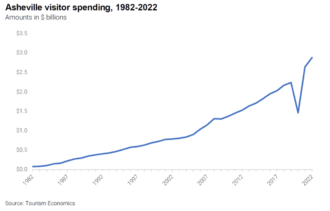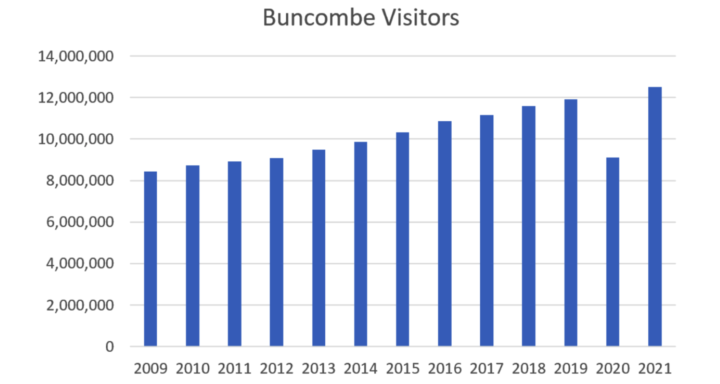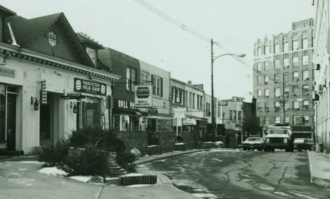By Sally Kestin, avlwatchdog.org
Turn on the television, open a magazine, or browse online in the Southeast, Washington, D.C., Denver, or beyond, and you’re likely to see an ad for Asheville.
“We build, we brew, we paint, we carve,” an announcer proclaims in one video. “Our goal isn’t to be perfect. It’s to be perfectly who we are, deeply rooted, and ever-evolving, drawing you in and calling you back again. You are welcome. Always, Asheville.”
And yet, it wasn’t always this Asheville. The hip and trendy vacation spot, the wedding and group meeting destination, the beer and foodie magnet, is largely a product of a self-perpetuating tourism machine.
Forty years ago, when hotels sat shuttered and virtually no one ventured downtown after business hours, the city’s business and elected leaders helped pass a tax on overnight visitors, the first in North Carolina, with the stipulation that its proceeds be used to advertise and promote Asheville to attract more visitors.
From that first year in 1983, when the occupancy tax generated $380,000, until now, when it is projected to reach $40 million, the jump-starting of a nascent tourism industry transformed Asheville and its economy. At least 65 hotels have opened in those four decades, almost half of them just since 2013, an Asheville Watchdog analysis found.

Visitor spending grew from about $80 million to nearly $3 billion a year. And the more visitors who came, the more money the tax generated, and the more was spent on advertising and promoting Asheville to attract more tourists.
In 2021, 12.5 million people visited Buncombe County, 46 tourists for every resident.
The thriving tourism industry in Asheville helps support the restaurants, art galleries, boutiques, and music venues that now occupy the once boarded-up storefronts. Tourism supports one out of seven jobs in Buncombe.
But those jobs typically don’t pay enough for many of the workers who serve tourists to be able to comfortably live in Asheville or buy a cocktail or dinner at a James Beard-nominated restaurant.
Buncombe’s tourism budget is the highest of North Carolina’s top 10 tourism markets because of the volume of visitors and the requirement that two-thirds of the tax money be spent on promotion. Tourism tax laws in some other counties allow for more to be spent on arts and cultural amenities, beach renourishment or general government expenses.
The Buncombe County Tourism Development Authority (TDA) has budgeted more than $100 million to market Asheville just since 2017. The sentiment among some locals is that unlike 40 years ago, when tourism provided desperately needed economic development, Asheville is now a well-known tourist destination, one no longer requiring extensive promotion.
“Maybe 40 years later, the thought that these taxes need to be used for promotional purposes, maybe that argument is no longer valid, that things have changed,” said Christopher McLaughlin, a professor of public law at the University of North Carolina’s School of Government. “Buncombe now, especially Asheville, has become this tourism monster, and you could argue the need is more to sustain the infrastructure in light of what we’re seeing from the impact of all the tourists.”

The TDA is run by a volunteer board whose voting members represent businesses that benefit from tourism. Brenda Durden, the TDA chair and a hotelier, said tourism and the many businesses that depend on it would suffer if the marketing of Asheville were reduced.
“A lot of people count on us to put food on the table, so I think that we cannot stop because it’s a competitive world out there,” said Durden, CEO of the Asheville Hotel Group. “Travel decisions are very often made just by who has the best marketing, and we want all those folks to come here.”
TDA’s mission: Inspire visitation
Asheville has always attracted tourists drawn to the beauty of the mountains and the healing powers of a cool climate and serene environment. The Omni Grove Park Inn, still the area’s largest hotel, opened in 1913.

By the 1970s, with convention hotels closing and downtown Asheville in decline, Asheville Area Chamber of Commerce executives turned to an idea showing promise in nearby states: taxing guests on hotel stays.
The 1983 law authorizing a 2% occupancy tax required the money be spent on advertising and promoting Asheville for tourism. Today, the tax is 6%, and two-thirds goes toward promotion and one-third to capital projects that encourage tourism.
Working as Explore Asheville Convention & Visitors Bureau, the TDA promotes Asheville “through advertising, marketing, public relations, and sales programs that inspire visitation.”
The marketing team manages ad campaigns that introduce Asheville to prospective visitors across platforms including radio, television, paid social media and sites such as TripAdvisor, Hulu, and Spotify.
Ads for Asheville have run in magazines including National Geographic Traveler, AAA Going Places, Parade, People, and Better Homes & Gardens.
One national campaign in spring 2018 reached 31% of U.S. adults ages 35-64. “More than 460 Explore Asheville broadcast spots aired on the Travel Channel, HGTV, and The Weather Channel,” a TDA annual report describing the campaign said.
A sales team represents Asheville at dozens of travel trade shows and conferences each year and hosts meeting planners for complimentary visits to attract groups and large events. The team’s travel schedule for this year includes more than 45 trips from Punta Cana, the Dominican Republic, to Palm Beach, Fla.
The public relations staff works media contacts to generate publicity and buzz, pitching story ideas, hosting journalists in Asheville and cultivating new sources on “media missions” in New York, Washington, Atlanta, and other places.
The PR staff takes credit for Asheville’s placement on many of those “best of” lists – “Best Cities for Art Lovers,” “Best Places to Retire,” and “#1 Foodie City” in the world.
“How do these national accolades and headlines happen again and again?” the 2019-20 annual report said. “Asheville businesses and makers are doing remarkable things worthy of national recognition, but it often takes a timely, behind-the-scenes push or connection made by media relations professionals to earn coverage.”
Tourism surge
The marketing blitz has brought steady and at times head-spinning growth in Asheville area tourism:
- Total visitors to Buncombe grew by 49% since 2009, from 8.4 million to 12.5 million in 2021. (More than one-third stayed overnight; the rest came for the day.)
- Hotel rooms nearly doubled from 4,874 in 1992 to 9,034 in 2022.
- Lodging sales, including vacation rentals and bed and breakfasts, increased nearly 700% from $79 million in 1996 to $633 million in 2022-23.
- Visitor spending grew 167% from 2000 to 2018, compared with the statewide average of 110%.
Tourism especially surged in recent years as short-term vacation rentals flourished. Occupancy tax revenue more than doubled just in the past seven years, from $16 million in 2016 to $36 million in 2022.
That money flowed to the TDA, and the budget for promoting Asheville continued to grow. Spending on marketing, advertising, sales and promotion — and a 35-person Explore Asheville staff — is budgeted this year at $27.5 million.
Benefits and ‘boosterism’
The benefits of Asheville’s prosperous tourism industry are undeniable, notably to hotels, but also to the restaurants, shops, and businesses that depend on visitor spending. Even a slight drop in tourists endangers the survivability of some, as The Watchdog reported in July.
For local residents, tourism provides far more options in arts, dining, shopping and entertainment. And the money generated by the occupancy tax that isn’t devoted to promotion has paid for capital projects intended to boost tourism but that also benefit residents.
The TDA has spent more than $80 million on capital projects including $7 million on the riverfront redevelopment in Asheville, nearly $7 million on the Buncombe sports complex in Enka, and $8 million on riverfront projects in Woodfin.
Tourism has transformed Asheville from “a very unfriendly downtown to what I think is one of the most beautiful downtowns in America,” said Durden, the TDA chair. “We wouldn’t have all the great places we have without our visitors.”
Tourism supports nearly 27,000 jobs, 14% of Buncombe’s total, according to a 2021 economic impact report for the TDA.
But those jobs tend to be low-paying. Some of the more common tourism jobs in Asheville paid on average about $27,000 to $32,000, a Watchdog analysis of 2022 federal labor statistics shows. The living wage in Buncombe, the earnings required for a single person to afford a one-bedroom apartment, is $20.10 an hour, or $41,800 a year, according to Just Economics of WNC.
Vic Isley, president and CEO of the TDA, said the federal earnings statistics can be skewed because they do not distinguish between full- and part-time jobs. She cited a presentation made to the TDA board in August that showed pay for leisure and hospitality jobs in Buncombe averaged $38,000 to $39,800 in 2022 — higher than the state average but still below the living wage.
Durden, the TDA chair and hotelier, said that among the many people employed by tourism, “You don’t hear from those folks who have made a life and a good living. They are not the squeaky wheel. We as tourism employers make a great life for a lot of people.”
Visitors brought in $2.88 billion to Buncombe’s economy in 2022, the TDA reported.
“Visitor spending, I would argue, is our strongest export,” said Kathleen Mosher, a board member and past chair of the TDA, who is vice president of communications for the Biltmore Co. “Visitors are bringing in net new dollars to the community and that is really sustaining the really vibrant, entrepreneurial, and independent business economy that we have.”
But the influx of 12.5 million people a year contributes to increased traffic, congestion at popular hiking trails and waterfalls, added trash in the landfill, and increased demand on water and sewer systems, and police and emergency workers.
Isley said that tourists and the businesses they support pay for those impacts with sales and property taxes. “The data shows that actually because of the taxes that visitors generate, that we as residents actually pay less taxes,” she said.
Durden said congestion is more a result of population growth. “I think traffic is really bad when it’s time for people to be going and coming from work, but that’s not typically when tourists are out,” she said. “We have lots of people who are new to our area, and that’s caused some housing issues, but housing is not what TDA is here to do. It is a definite crisis in our area that needs attention, but it’s just not what the TDA is set up to do.”
Only the positive impacts of tourism — the economic benefits of visitor spending, job creation, and tax revenue — are touted by the TDA and the tourism industry. TDA reports refer to the snowball effect of tourists and taxes as “the virtuous visitor cycle.”
Brian King, head of the Texas A&M department of hospitality, hotel management and tourism, calls that “the phenomenon of boosterism.”
Tourism development agencies have “an interest in talking things up,” King said. “There’s a whole kind of sector presenting all the positives, particularly those doing the promotions.”
In the tourism field over the past 50 to 60 years, King said, “there has been much more conversation about looking not just at economic pros and cons, but also the social, cultural, environmental” impacts of tourism.
“If you create a machine which is just ramping up the visitation, then it may get out of alignment with the interests of the local residents,” King said. “Public officials should be looking after the quality of life for the residents.”
Spend less on promotion, some locals say
Asheville’s economic problems are significant: rents that are among the highest in North Carolina, a shortage of affordable housing, and low wages that force many service workers to take in roommates or live outside the city.
Bri Snyder, 22, who uses they/them pronouns, is a barista at a downtown coffee shop and has worked at jobs catering to tourists. In Snyder’s previous job, half of their $1,600 monthly pay went toward rent.
“There is no room for a mistake, like I can’t break anything or get sick,” Snyder said.
Snyder graduated in May from UNC Asheville with a degree in management but said they can’t find a job that pays better than the coffee shop. Snyder grew up in Bryson City and visited Asheville as a child, dreaming of one day living here.
“I’m finally here and I can’t afford to do any of the things that I dreamed of,” they said. “I do feel like some of those things should be a right that I have, like enjoying the cuisine here every once in a while.”
Joel Adams, 70, an Asheville native and retired financial advisor, said he believes Buncombe is over-reliant on tourism, and the quality of life has suffered.
“The reason we have the need for affordable housing is because we’ve created an economy with low-wage jobs,” he said. “We have had to use philanthropic resources to provide housing, which is a subsidy to our tourism industry.”
Adams said traffic “is horrendous because we do not have the infrastructure to accommodate the business that we are marketing.”
Parking at the Asheville Regional Airport, which recently started a $400 million expansion and is one of the fastest growing airports in the country, has become more difficult.
“You have to arrive hours and hours before a flight,” Adams said. On a recent return flight to Asheville, he said, he sat on the plane for an hour and a half after landing as it waited for a gate to open. “It’s a shit show,” he said.
Adams said he now hikes in Macon County, which is “not on the map for most of the tourists,” because the trails in Buncombe are too crowded.
Adams recalls the Asheville of the 1980s and said tourism succeeded in revitalizing downtown, but “it’s obviously overshot the mark.”
He said he believes far less should be spent marketing Asheville to tourism today.
“Why promote it?” he said. “It’s worked. We’ve got more than we can handle.”
Additional reporting by Andrew Jones and John Boyle.
Asheville Watchdog is a nonprofit news team producing stories that matter to Asheville and Buncombe County. Sally Kestin is a Pulitzer Prize-winning investigative reporter. Contact her at skestin@avlwatchdog.org.To show your support for this vital public service go to avlwatchdog.org/donate.





Before you comment
The comments section is here to provide a platform for civil dialogue on the issues we face together as a local community. Xpress is committed to offering this platform for all voices, but when the tone of the discussion gets nasty or strays off topic, we believe many people choose not to participate. Xpress editors are determined to moderate comments to ensure a constructive interchange is maintained. All comments judged not to be in keeping with the spirit of civil discourse will be removed and repeat violators will be banned. See here for our terms of service. Thank you for being part of this effort to promote respectful discussion.